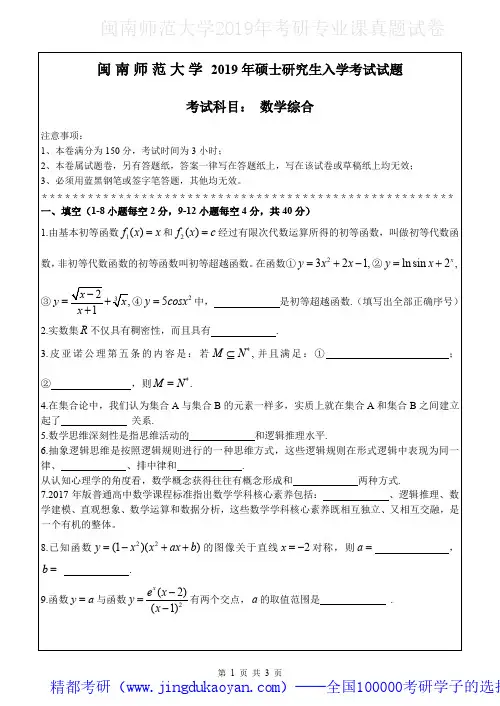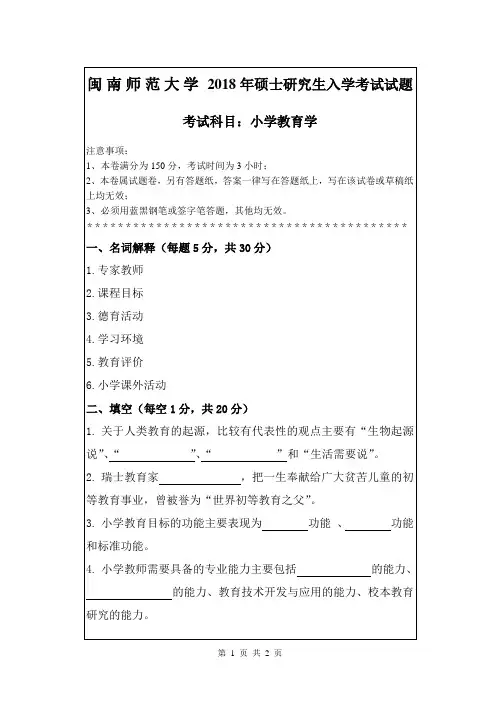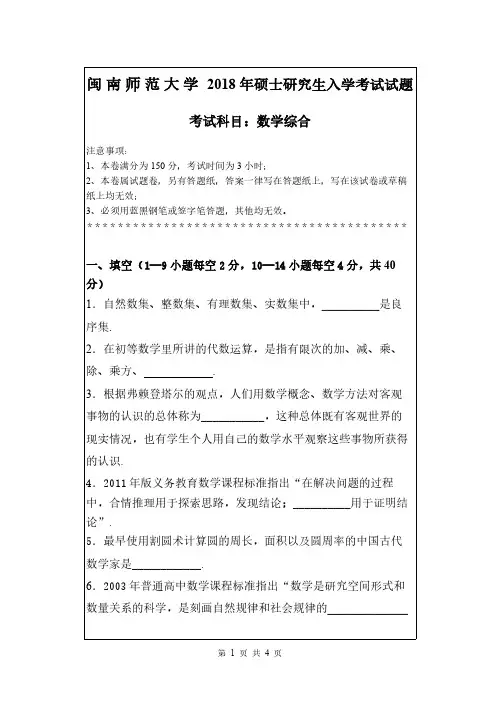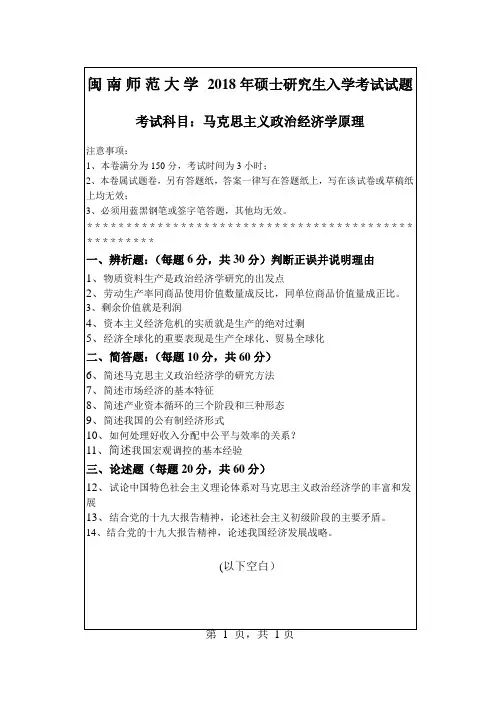闽南师范大学2018年硕士研究生入学考试试题-数学综合
- 格式:doc
- 大小:159.50 KB
- 文档页数:4

闽南师范大学2018年硕士研究生入学考试试题考试科目:幼儿园课程注意事项:1、本卷满分为150分,考试时间为3小时;2、本卷属试题卷,另有答题纸,答案一律写在答题纸上,写在该试卷或草稿纸上均无效;3、必须用蓝黑钢笔或签字笔答题,其他均无效。
******************************************一、名词解释(每小题5分,共30分)1.幼儿园课程编制2.鹰架教学3.学科中心课程4.方案教学活动5.高结构幼儿园课程目标6.主题教学活动二、简答题(以下五题任选四题做答,每小题10分,共40分)1.简述主要的幼儿园课程目标的取向。
2.简述我国20世纪二三十年代的幼儿教育工作者对幼儿园课程含义的观点。
3.简述进行幼儿园健康教育的途径。
4.简述维果茨基的理论对幼儿园课程启示。
5.简述不同结构化程度的幼儿园教育活动内容选择和组织的趋向。
三、论述题(每小题20分,共40分)1.结合你了解的幼儿园课程实施的实际,论述影响幼儿园课程实施的因素。
2.结合有关游戏与教学的关系原理,举例说明你在工作实践中如何实现游戏与教学的优化结合。
四、活动设计题(以下二题任选一题做答。
每小题40分,共40分。
)1.设计《我的家乡》单元主题活动,并写出活动方案(40分)至少包含主题网络图、主题总目标、环境创设与资源开发、活动过程等四部分。
每个部分10分。
2.设计《我的家乡》方案教学活动,并写出活动方案。
(40分)至少包含起始阶段、探索阶段、成果展示与评价三个阶段中儿童提出问题、解决问题与成果展示的过程及教师的支持策略。
每个阶段13-14分)(以下空白)。





闽南师范大学2018年硕士研究生入学考试试题
考试科目:数学综合
注意事项:
1、本卷满分为150分,考试时间为3小时;
2、本卷属试题卷,另有答题纸,答案一律写在答题纸上,写在该试卷或草稿纸上均无效;
3、必须用蓝黑钢笔或签字笔答题,其他均无效。
******************************************
一、填空(1—9小题每空2分,10—14小题每空4分,共40分)
1.自然数集、整数集、有理数集、实数集中,__________是良序集.
2.在初等数学里所讲的代数运算,是指有限次的加、减、乘、除、乘方、.
3.根据弗赖登塔尔的观点,人们用数学概念、数学方法对客观事物的认识的总体称为___________,这种总体既有客观世界的现实情况,也有学生个人用自己的数学水平观察这些事物所获得的认识.
4.2011年版义务教育数学课程标准指出“在解决问题的过程中,合情推理用于探索思路,发现结论;__________用于证明结论”.
5.最早使用割圆术计算圆的周长,面积以及圆周率的中国古代数学家是____________.
6.2003年普通高中数学课程标准指出“数学是研究空间形式和数量关系的科学,是刻画自然规律和社会规律的______________
第 1 页共 4 页。


闽南师范大学2018年硕士研究生入学考试试题考试科目:写作与翻译注意事项:1、本卷满分为150分,考试时间为3小时;2、本卷属试题卷,另有答题纸,答案一律写在答题纸上,写在该试卷或草稿纸上均无效;3、必须用蓝黑钢笔或签字笔答题,其他均无效。
******************************************I. Translation: translate the following passage into Chinese (40 points)Compared to Grammar Translation Method(GTM), Audio-lingual Method(ALM) does recognize the importance of the ability to produce and understand spoken forms of the L2. It only partially prepares learners, however, for the realities of normal spoken language. The rigid emphasis on correct production of form with only secondary concern for the meanings expressed often results in learners whose knowledge of L2 structures is ‘fixed’ in the memory, but whose ability to use them to express and understand real intentions is very limited. The structures are linked to the dialogues in which they are presented and the drills in which they have been practised. Learners have little or no chance to practise their use outside these very narrow contexts. Real-life use of the L2 knowledge can, therefore, be difficult. The ALM has thus been criticized for producing learners who know a lot, but are unable to use what they know to DO anything in the L2.Both the GTM and the ALM may succeed in fixing the rules of L2, up to sentence level, in the long-term memory. Successful learners should know what are and are not acceptable strings of language according to the L2 rule system. They may also succeed in developing their knowledge of L2 vocabulary items, though with little discrimination as to the frequency and usefulness of the items the Mental Lexicon contains. Neither method though can, alone, prepare learners for the world of natural L2 use, especially the use of spoken language, where rules are not always followed and where it is at least as important to be able to express and understand meanings quickly, in a natural, spontaneous, appropriate way as it is to be able to express them with 100% grammatical accuracy.II. Translation: translate the following passage into English (35 points)第二语言习得的研究者们提出的主要论点是这样一个有争议的问题:在第二语言教学中,是否应该包括语法,怎样把语法包括在内。